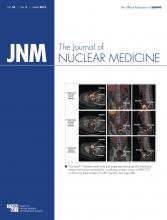Abstract
This phase 1 study was performed to determine the pharmacokinetics and ability to visualize prostate cancer in bone, soft-tissue, and the prostate gland using 123I-MIP-1072 and 123I-MIP-1095, novel radiolabeled small molecules targeting prostate-specific membrane antigen. Methods: Seven patients with a documented history of prostate cancer by histopathology or radiologic evidence of metastatic disease were intravenously administered 370 MBq (10 mCi) of 123I-MIP-1072 and 123I-MIP-1095 2 wk apart in a crossover trial design. 123I-MIP-1072 was also studied in 6 healthy volunteers. Whole-body planar and SPECT/CT imaging was performed and pharmacokinetics studied over 2–3 d. Target-to-background ratios were calculated. Absorbed radiation doses were estimated using OLINDA/EXM. Results: 123I-MIP-1072 and 123I-MIP-1095 visualized lesions in soft tissue, bone, and the prostate gland within 0.5–1 h after injection, with retention beyond 48 h. Target-to-background ratios from planar images averaged 2:1 at 1 h, 3:1 at 4–24 h, and greater than 10:1 at 4 and 24 h for SPECT/CT. Both agents cleared the blood in a biphasic manner; clearance of 123I-MIP-1072 was approximately 5 times faster. 123I-MIP-1072 was excreted in the urine, with 54% and 74% present by 24 and 72 h, respectively. In contrast, only 7% and 20% of 123I-MIP-1095 had been renally excreted by 24 and 72 h, respectively. Estimated absorbed radiation doses were 0.054 versus 0.110 mGy/MBq for the kidneys and 0.024 versus 0.058 mGy/MBq for the liver, for 123I-MIP-1072 and 123I-MIP-1095, respectively. Conclusion: 123I-MIP-1072 and 123I-MIP-1095 detect lesions in soft tissue, bone, and the prostate gland at as early as 1–4 h. These novel radiolabeled small molecules have excellent pharmacokinetic and pharmacodynamic profiles and warrant further development as diagnostic and potentially when labeled with 131I therapeutic radiopharmaceuticals.
Footnotes
↵† Deceased.
Published online Jan. 9, 2013.
- © 2013 by the Society of Nuclear Medicine and Molecular Imaging, Inc.







